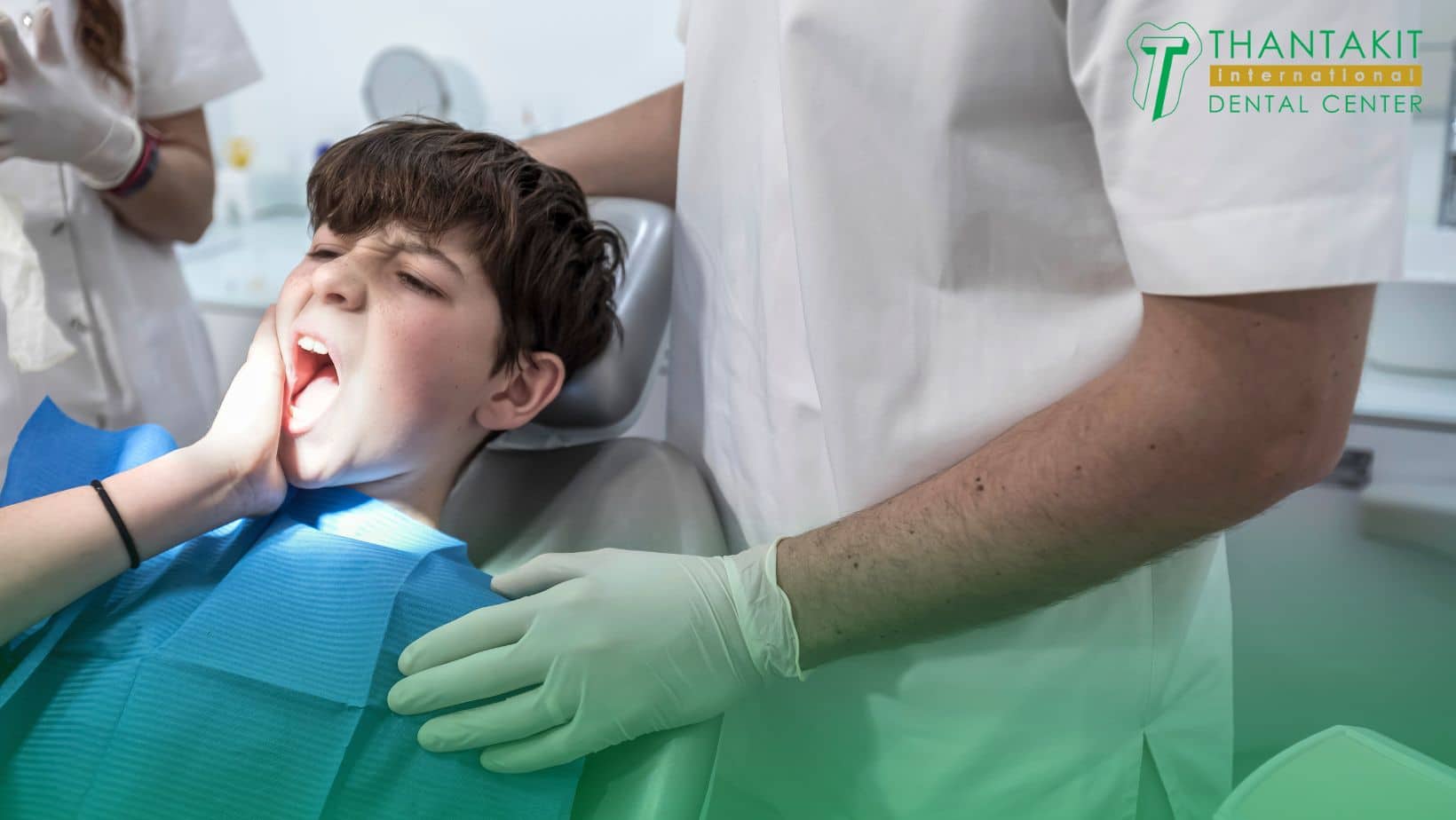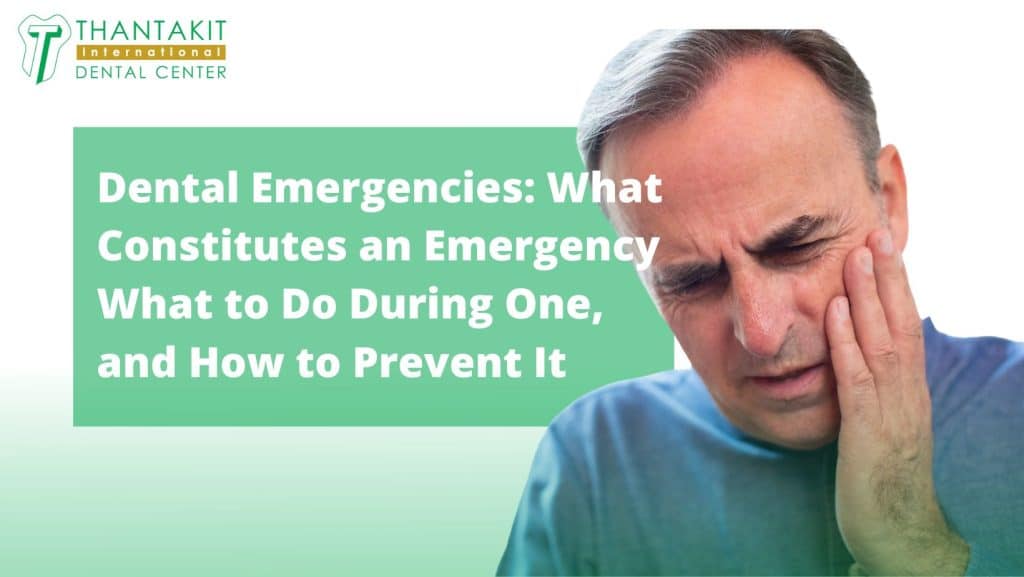Dental Emergencies: A discussion on what constitutes a dental emergency, what to do in case of a dental emergency, and how to prevent dental emergencies.
When you’re working with a dental emergency, time is essential. It requires immediate attention if it’s a true emergency. You can’t wait around because certain teeth or gum injuries can get worse over time with further complications if you don’t hurry.
A dentist should be contacted immediately, or you should go to the emergency room ASAP for dental emergencies treatment.
Page Contents
What are Dental Emergencies?
A dental emergency is when you end up with a teeth-related, gum-related, or even jaw-related problem that requires immediate treatment without any delays for tomorrow or next week.
It might be a result of blunt-force trauma from abuse or getting mugged as well as ending up in a car accident. Or it could be from dental hygiene neglect.
Not all dental-related issues can be considered dental emergencies though. You must watch out for the symptoms or, at times, err on the side of caution.
For example, if the pain is severe and the bleeding won’t stop no matter how much medicine you take, it might be time to get checked-in at the clinic. It’s the same deal for those with broken facial bones or oral complications.
In such cases, you should go straight to E.R. In regard to what specifically is considered a dental emergency, they include the following:
- Severe toothache.
- Knocked-out tooth.
- Badly cracked tooth.
- Lost or broken dental restorations.
- Extruded (partially dislodged) tooth.
- Dental abscess (your jaw and face are swelling in pain).
- Severe soft tissue injury (like an oral laceration or your lips are busted).
What to Do During Dental Emergencies
If you’re facing one of many dental emergencies happening daily in the U.S.A. and beyond, you should first call the dentist for more info and instructions.
There are dentists out there who’ll give you an emergency number to call even if it’s already after regular business hours. It’s supposed to only be used for emergencies only.
If you don’t have a dentist to phone, call the national emergency number instead—in the U.S., it is 911; in the U.K., it’s 112; in the E.U., it’s 112—to avail of the nearest urgent care center or hospital emergency room.
For most emergencies like a knocked-out or broken tooth, the dentist will treat you in their clinic or center. As for serious injuries involving severe pain like shattered facial bones, you should go straight to the E.R.

Managing Dental Emergencies Properly
Let’s make a rundown on how to deal with emergencies of a dental nature before seeing the dentist himself. You should know how to manage your issue prior to reaching the dental center.
-
Severe Toothache: Before going to an emergency room, first thoroughly rinse your mouth with warm water. Get dental floss to remove any lodged food inside there in case that’s what’s causing you pain.
If you have a swollen mouth, apply a cold compress on your cheek or jaw. Drink pain relievers you’ve gotten over the counter like ibuprofen, naproxen, or acetaminophen (as long as you’re not allergic to any of them).
Don’t put aspirin or other painkillers directly against your teeth or gums because they’re capable of burning through your gums.
Focus mostly on keeping any swelling down and pain relief for now. Afterwards, go to the dentist immediately to get that tooth treated, saved, or extracted.
-
Badly Cracked Tooth: To manage your badly cracked tooth, save and rinse any broken pieces of your teeth that might be of use to the dentist later. Rinse your mouth with warm water as well, like in the previous emergency.
If you’re bleeding, apply a piece of gauze on the affected area for 10 minutes or until the tooth or gums stop bleeding. Apply a cold compress to your mouth or cheek around where the broken or chipped tooth is located for good measure.
-
Knocked-Out Tooth: So, you’ve gotten a tooth knocked out due to an accident at home, roughhousing, or full-contact combat sports. Retrieve the tooth by its crown (the visible part of it above the gums) then rinse it with water.
Avoid removing any attached tissue fragments or scrubbing it with a toothbrush. If you could, put your tooth back into the socket and make sure it’s facing the correct direction. Otherwise, don’t bother. Don’t force that tooth in place.
Save the tooth by placing it inside a small container of milk or a cup of water with a pinch of table salt onto it if you don’t have any milk available. Even better, avail of a cell growth medium product such as Save-a-Tooth®.
See your dentist as soon as you can. He’ll know how to save a knocked-out tooth within an hour of its removal or decide if your best course of action is getting a bridge, crown, dentures, or dental implant.
-
Partially Dislodged Tooth: If you have an extruded tooth, see your dentist immediately. For pain relief until you’re at the dental center, apply a cold compress to the outside of your cheek, jaw, or mouth around the affected tooth.
You can further manage the pain with an OTC pain reliever like before, such as ibuprofen, acetaminophen, or naproxen if required.
-
Swollen Areas or Pimple-Like Oral Infections: If you have a dental abscess, it means there are pimple-like infections and swelling occurring at the root of your tooth or the space between the gums and teeth.
Abscesses are serious and severe. They can damage the surrounding teeth’s tissue and the teeth itself. If you leave it untreated, it could cause your whole jaw or face to swell. The infection could also spread to other parts of your body.
To manage it and draw out the pus to the surface of your mouth for immediate removal by spitting, rinse your mouth with a mild saltwater solution of ½ teaspoon of table salt on 8 ounces of water several times a day.
-
Severe Soft Tissue Injury: If you’ve injured your lips, gums, cheeks, or tongue, then that’s a soft tissue injury that can result in mild to heavy bleeding. To control your blood loss, do the following things.
-
Make a mild saltwater solution using ½ teaspoon of table salt on 8 ounces of water and rinse your mouth with it.
-
Apply pressure to the bleeding site using a moist piece of gauze or a caffeinated tea bag. Hold it in place for 15-20 minutes.
-
Blood vessels can shrink, and bleeding can slow down with the assistance of tea bags because of its tannic acid.
-
Control the bleeding by pressing the cold compress on the proximity of the affected area, by either your cheek or mouth, for 5-10 minutes.
-
If the bleeding keeps flowing, see your dentist ASAP or go to the nearest hospital ER.
-
Continue applying pressure to the site with the cold compress until the dentist or doctor can attend to you.
-
Lost or Broken Dental Restoration: Your old filling, crown, or bridge can become dislodged and fall out. If your restoration ends up missing, stick a piece of sugarless gum into the cavity (because sugary gum can cause pain).
You can also buy OTC dental cement as a temporary fix. As for missing bridges or damaged crowns, make an appointment with your dentist and bring the restoration with you in case you still have it. Otherwise, you’ll have to pay for a new restoration.
Put your crown or bridge back in place if it’s possible. Use dental cement, denture adhesive, or toothpaste to help hold it into place. All the same, call your dentist ASAP to get everything fixed immediately.

Are You Experiencing a Dental Emergency or Not?
Some situations are dental emergencies, and some aren’t. The difference being that some situations can allow you to see your dentist tomorrow or at a scheduled appointment without you fearing immediate complications or permanent damage.
You should still see your dentist ASAP, but some emergencies are more high priority than others, often necessitating an expensive ambulance ride or a car ride straight to the nearest emergency room.
Other situations allow you to make regular business hour appointments. Issues that aren’t emergencies and can wait include the following.
- Broken braces.
- Mild or dull toothache.
- Object stuck between the teeth.
- Small crack or chip on your tooth or teeth.
- Minor soft tissue injury like mouth sores or small cuts.
Don’t forget that any dental issue involving severe pain or bleeding requires immediate dental attention and treatment from the dentist or healthcare provider nearest you.
How to Prevent Dental Emergencies
There are many things you can do to prevent dental emergencies. For one thing, be careful of accidents. For another thing, observe proper dental hygiene upkeep or maintenance.
Follow the helpful dental emergency prevention advice listed below.
-
Take Note of Any Persistent Dental Pain: Are you suffering from persistent dental pain? For instance, cavities can cause you a nagging toothache; ditto with fillings that have crumbled or ended up leaking.
Tooth pain is your main red flag of some major dental malfunction, but if it’s a temporary pain you might be tempted to ignore it.
Don’t ignore that red flag! You might have a severe tooth infection that has killed the tooth nerve, leading you to think that the infection has resolved itself when it’s impossible to do so without proper dental treatment.
The sooner you go to your dentist for a checkup, the more likely you can save your tooth and resolve your dental problem.
-
Don’t Ignore Teeth, Gums, or Mouth Changes: Did your mouth tissue, gum tissue, or teeth surface have any changes to them? If so, call your dental doctor immediately.
If you’ve noticed any changes to your oral tissues like your tongue, gums, the roof and floor of your mouth, or the insides of your mouth and lips, then consult your dentist post-haste. Call him over the phone about it or schedule a checkup.
You also need professional medical investigation for any mouth sores, injuries, and oral ulcers that fail to properly heal.
-
The Maintenance of a Superb Dental Care Regimen: You’ve heard it before, but it bears repeating. Brush your teeth at least twice daily. Brush your teeth as soon as you wake up and before you sleep. Or even right after meals.
When tooth-brushing, brush your teeth for at least two minutes. This allows you enough time to adequately brush every individual tooth to ensure thorough cleaning and dental emergencies prevention.
You can also use an electric toothbrush as well with its built-in timer and automatic brushing strength setting. Otherwise, keep a timer handy and manually brush your teeth using small tight circles instead of just brushing back and forth or up and down.
-
Regular Toothbrush Replacement: Your toothbrush should be treated more like a wet wipe or tissue paper. No matter how thoroughly you clean it after use, some of the gunk from your teeth will inevitably remain on its bristles.
There will come a time when you can’t reuse it anymore due to all the gunk residues. On average, you should replace your toothbrush after two to three months or as soon as it begins to look splayed or worn.
As for electric toothbrushes, they have built-in indicators on when to replace their toothbrush head. It should be easy to know when to get a replacement head for such a device.
Toothbrushes only cost a few dollars, even when it comes to replacement electric toothbrush heads. You can use the worn toothbrushes to clean auto parts or shoes if you wish to recycle them.
-
Interdental Cleaning is Important: Interdental cleaning means cleaning between the gaps of your individual teeth. The most straightforward way to do so is flossing with dental floss.
You can also use interdental brushes to clean between bridges or dentures. Soft picks look like guitar picks with bits of floss you can slip between teeth to remove food debris and plaque.
The Waterpik is a product that combines a soft pick with a water jet so that you can clean and rinse your teeth simultaneously during interdental cleaning. Failure to floss leaves about a third of your teeth unclean.
It also increases your risk for gum disease (gingivitis) and tooth decay (dental caries). Fair warning—dentists can tell at a glance who flosses and who doesn’t. Ask your hygienist or dentist for help if you’re finding difficulty cleaning in between your teeth.
-
Reduce the Amount of Sugar You Consume: Sugar reduction by cutting down on your desserts, snacks, junk food, fast food, and soda consumption will prevent plaque and tartar formation on your teeth.
Even though enjoying sugary treats occasionally is amazing, do so sparingly. Excessive sugar consumption increases mouth acidity, even if you were to stave it off with regular tooth-brushing and flossing.
The acid comes from the waste products of bacteria that have formed the plaque over your teeth that they also feed into. Plaque, by the way, is made of sugars and starches you’ve consumed. The acid weakens your enamel by eating away at its essential minerals, resulting in holes or cavities.

Find a Dentist Who Takes Your Fears Seriously
Find a dentist who’ll take your dental anxiety or fears seriously. You should also avail of the services of professionals you can trust, particularly if you’re having dental emergencies outside of your locality, like when you’re on vacation or something.
If you were to suffer from a dental emergency while touring places like Thailand, you might end up needing treatment over there ASAP at dental centers like Thantakit for good measure.
Book a dental tour at the Thantakit Dental Center in Thailand ASAP. You won’t regret it.
Thantakit International Dental Center is Thailand’s longest established dental center. Located in the bustling city of Bangkok, our clinic is renowned across the world as a destination for world-class dentistry, with most of our patients flying to us from Australia.
Get in touch with us today and get a dental consultation for FREE!












